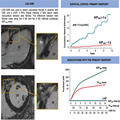Abstract and Introduction
Abstract
Aims: To determine whether myocardial fibrosis and greyzone fibrosis (GZF) on cardiovascular magnetic resonance (CMR) is associated with ventricular arrhythmias in patients with coronary artery disease (CAD) and a left ventricular ejection fraction (LVEF) >35%.
Methods and Results: In this retrospective study of CAD patients, GZF mass using the 3SD method (GZF3SD) and total fibrosis mass using the 2SD method (TF2SD) on CMR were assessed in relation to the primary, combined endpoint of sudden cardiac death, ventricular tachycardia, ventricular fibrillation, or resuscitated cardiac arrest. Among 701 patients [age: 65.8 ± 12.3 years (mean ± SD)], 28 (3.99%) patients met the primary endpoint over 5.91 years (median; interquartile range 4.42–7.64). In competing risks analysis, a GZF3SD mass ≥5.0 g was strongly associated with the primary endpoint [subdistribution hazard ratio (sHR): 17.4 (95% confidence interval, CI 6.64–45.5); area under receiver operator characteristic curve (AUC): 0.85, P < 0.001]. A weaker association was observed for TF2SD mass ≥23 g [sHR 10.4 (95% CI 4.22–25.8); AUC: 0.80, P < 0.001]. The range of sHRs for GZF3SD mass (1–527) was wider than for TF2SD mass (1–37.6).
Conclusions: In CAD patients with an LVEF >35%, GZF3SD mass was strongly associated with the arrhythmic endpoint. These findings hold promise for its use in identifying patients with CAD and an LVEF >35% at risk of arrhythmic events.
Graphical Abstract: Late gadolinium enhancement cardiovascular magnetic resonance (LGE-CMR) was used to detect myocardial fibrosis in patients with coronary artery disease (CAD). As shown in the horizontal long axis (left upper panel) and short-axis views (left lower panel) of the left ventricle, areas of greyzone fibrosis are typically heterogeneous, often harbouring ‘channels’ in between areas of myocardial fibrosis. As shown in the survival curves (right upper panel), the proportional risk of the primary endpoint increased with increasing greyzone fibrosis mass using the 3SD method (GZF3SD). In comparison to left ventricular ejection fraction (LVEF) and total fibrosis mass, this risk, expressed in terms of subdistribution hazard ratios (sHRs) from competing risks analyses, was much higher for GZF3SD than for total fibrosis mass using the 2SD method, or LVEF (right lower panel). LV, left ventricle; RV, right ventricle.
Introduction
Current guidelines recommend implantable cardioverter-defibrillators (ICDs) for the prevention of sudden cardiac death (SCD) in survivors of ventricular fibrillation (VF) or sustained ventricular tachycardia (VT), and for its primary prevention in patients with a left ventricular ejection fraction (LVEF) ≤30% or ≤35%, depending on functional class.[1] These cut-offs of LVEF were based on the inclusion criteria of the core ICD trials rather than on a previous validation of LVEF as a predictor of ventricular arrhythmias or benefit from ICDs. Within these cut-offs, there is no doubt that ICDs are effective. However, most primary prevention ICD recipients selected on the basis of an LVEF ≤35% do not receive therapy from the device. On the other hand, most patients succumbing to SCD have an LVEF >35%, both after myocardial infarction (MI) and in the general population.[2]
Several authorities,[2] including the National Heart, Lung and Blood Institute and Heart Rhythm Society,[3] have recognized the inability of LVEF to predict arrhythmic events and have called for alternative risk stratification tools. Cardiovascular magnetic resonance (CMR) has emerged as a promising alternative. Myocardial fibrosis (MF), identified using late gadolinium enhancement, has been linked to ventricular arrhythmias in numerous studies.[4,5] In addition, the so-called greyzone fibrosis (GZF), an admixture of MF and viable tissue thought to be a substrate for ventricular arrhythmias, identifiable with CMR, has also been shown to be associated with ventricular arrhythmias in clinical studies.[6]
The recent Cardiovascular Magnetic Resonance—Sudden Cardiac Death (CMR-SCD) study, which included patients with coronary artery disease (CAD) and a wide range of LVEFs, showed that GZF was as a strong predictor of SCD and a composite, arrhythmic endpoint of SCD, resuscitated cardiac arrest, VF or VT.[7] It also showed that 49% of SCDs occurred in patients with an LVEF >35%. The present subanalysis of the CMR-SCD study explores whether MF and GZF are associated with arrhythmic events in patients with CAD and an LVEF >35%.


